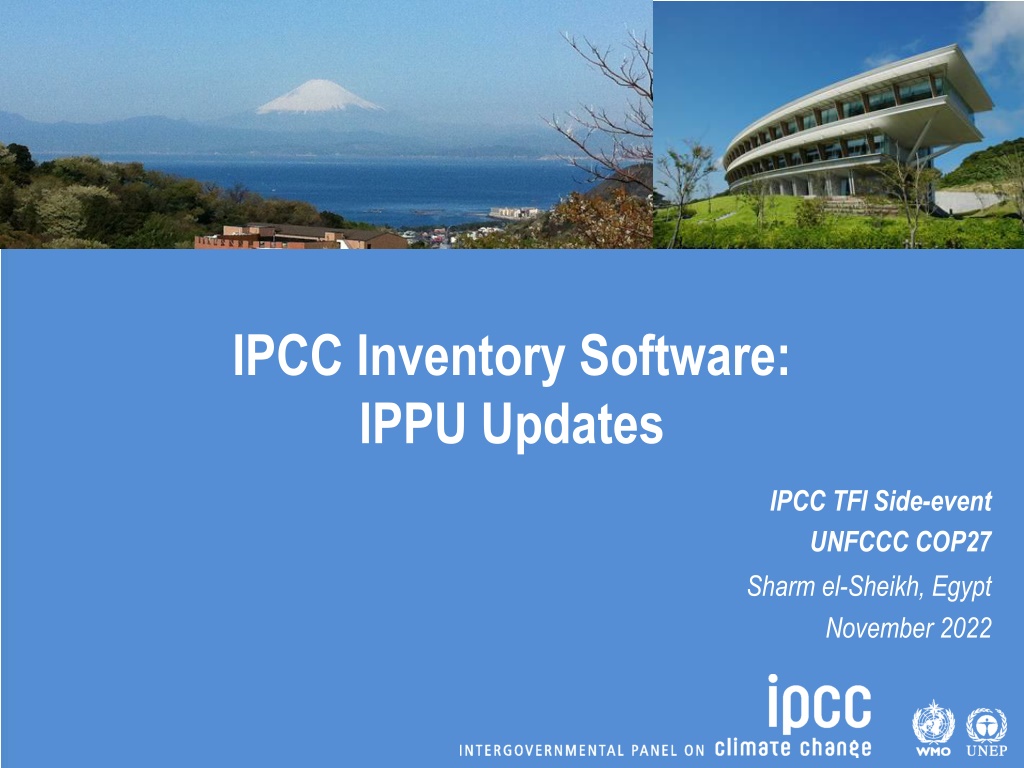IPCC Inventory Software and Updates for COP27 Side-event
IPCC Inventory Software and IPPU Updates offer new features like higher tiers, category subdivisions, and options for selecting production processes and materials. Users can access various worksheets for different industrial sectors like Mineral, Chemical, Metal, Electronics, and more, with detailed information on Tier levels and specific production processes. The tools provide flexibility for users to input country- or plant-specific values and technologies, contributing to improved data accuracy and analysis for industrial emissions tracking and reporting.
Download Presentation

Please find below an Image/Link to download the presentation.
The content on the website is provided AS IS for your information and personal use only. It may not be sold, licensed, or shared on other websites without obtaining consent from the author. Download presentation by click this link. If you encounter any issues during the download, it is possible that the publisher has removed the file from their server.
E N D
Presentation Transcript
IPCC Inventory Software: IPPU Updates IPCC TFI Side-event UNFCCC COP27 Sharm el-Sheikh, Egypt November 2022
IPPU Main Updates o Implementation of higher Tiers Higher Tiers mean more disaggregated data are needed, i.e. technology-specific EFs and plant-specific data A user may use a mix of Tiers within the same category o Introduction of a category subdivisions (e.g. national, region, plant, etc.) A user can enter a single subdivision (e.g., a national level) or many user-defined sub-divisions (e.g., prefectures or facilities) o More possibilities to select production processes and materials Users can disaggregate each category according to its national circumstances according to country-specific technologies, production processes and input materials, and to enter country- or plant-specific values (EFs and parameters) user-defined technologies,
Worksheets Menu (Tiers) Default or User-defined process/technology Default or User- defined parameter Sub-divisions Example of a Worksheet
IPPU Worksheets Number of Worksheets IPCC Category 2 - Industrial Processes and Product Use (IPPU) 2.A - Mineral Industry 28 2.B - Chemical Industry 89 2.C - Metal Industry 38 2.D - Non-Energy Products from Fuels and Solvent Use 3 2.E - Electronics Industry 24 2.F - Product Uses as Substitutes for Ozone Depleting Substances 21 2.G - Other Product Manufacture and Use 42 2.H - Other 6 251
2.A Mineral Industry Number of Worksheets IPCC Tiers Tier 2 IPCC Category Total Tier 1 Tier 3 2.A - Mineral Industry 2.A.1 - Cement production 2 4 1 8 (cement AD, ExIm, default EF) (plant-specific AD, emissions total) (clinker AD, CKD) 1 (capture/reduction for all Tiers) 1 (LKD, correction) 1 (capture/reduction) 1 (worksheet for Tier 1 and 2) 1 (capture/reduction) 2.A.2 - Lime production 3 1 6 (plant-specific AD) (default EFs) 2.A.3 - Glass Production 1 3 (for each furnace) 2.A.4 - Other Process Uses of Carbonates 2.A.4.a - Ceramics 2 (worksheets can be used for all Tiers: Tier 1 defaults, Tier 2 data on limestone/dolomite use, Tier 3 carbonates AD, calcination) 2 (worksheets can be used for all Tiers, same as 2A4a) 2 (worksheets can be used for all Tiers, same as 2A4a) 2 (worksheets can be used for all Tiers, same as 2A4a), 1 (for reporting issues) 2 (1 generic worksheet AD x EF, 2 2.A.4.b - Other Uses of Soda Ash 2.A.4.c - Non Metallurgical Magnesia Production 2.A.4.d - Other (please specify) 2 2 3 2.A.5 - Other (please specify) 2* 1 capture/reduction) * Implements generic equation (AD x EF). No default values are provided in the 2006 IPCC Guidelines
2.B Chemical Industry Number of Worksheets IPCC Category IPCC Tiers Tier 2 Total Tier 1 Tier 3 2.B - Chemical Industry 2.B.1 - Ammonia Production 2 (1 for all Tiers, where Tier 3 plant-specific, 1 for capture/reduction) 1 (AD x EF) abatement) 1 (capture/reduction) 1 (same as 2.B.2) (same as 2.B.2) 1 (capture/reduction) 1 (same as 2.B.2) (same as 2.B.2) 1 (capture/reduction) 3 (for all Tiers same equation, where Tier 3 plant-specific data.1 worksheet for carbide production, 1 for carbide use in acetylene, 1 for capture/reduction ) 1 (AD x EF) oxidation) 1 (capture/reduction) 2 (same equation for two tiers, 1 worksheet for capture/reduction) 2 2.B.2 - Nitric Acid Production 1 (AD x EF plus -- 3 (measurements) 2.B.3 - Adipic Acid Production 1 3 -- (measurements) 2.B.4 - Caprolactam, Glyoxal and Glyoxylic Acid Production 1 3 -- (measurements) 2.B.5 - Carbide Production 3 2.B.6 - Titanium Dioxide Production 1 (carbon content and 3 -- (no Tier 3) 2.B.7 - Soda Ash Production -- 2 (measurements)
2.B Chemical Industry - Petrochemicals Number of Worksheets IPCC Tiers Tier 1 IPCC Category Total Tier 2 Tier 3 2.B.8 - Petrochemical and Carbon Black Production 2.B.8.a - Methanol 1 (AD, feedstock, technologies) 2 (1 for CO2, 1 for CH4) 4 (combustion, flares, vents + CH4 atm.measurement) 1 (only CO2, mass- balance approach) 1 (capture/reduction) 1 9 2.B.8.b - Ethylene 2 9 4 1 1 2.B.8.c - Ethylene Dichloride and Vinyl Chloride Monomer 2 1 4 9 1 1 2.B.8.d - Ethylene Oxide 2 1 9 4 1 1 2.B.8.e - Acrylonitrile 2 1 9 4 1 1 2.B.8.f - Carbon Black 2 1 9 4 1 1 The same guidance for all 2.B.8 sub-categories 2.B.8. a, b, c, d, e, f
2.B Chemical Industry - Fluorochemicals Number of Worksheets IPCC Category IPCC Tiers Tier 2 Total Tier 1 Tier 3 2.B.9 - Fluorochemical Production 2.B.9.a - By-product emissions 8 2 (1 for HFC-23 direct method, 2 for HFC-23 proxy method, 2 HFC-23 monitoring method, 1 for other F-gases direct, 2 for others proxy method ) 1 (1 for HFC-23, 1 for other F- gases) (for HFC-23 based on efficiencies) 12 1 (capture/reduction) [under development] 2.B.9.b - Fugitive Emissions 2 (for all others, 1 capture/reduction) 2 2.B.10 - Other (Please specify) 2* 2 (1 generic worksheet AD x EF, 1 capture/reduction)
2.C Metal Industry Number of Worksheets IPCC Tiers Tier 1 IPCC Category Total Tier 2 Tier 3 2.C - Metal Industry 2.C.1 - Iron and Steel Production 2 6 (2 for Coke in Energy, 1 for Iron&Steel, 1 for Sinter, 1 for Pellets, 1 for DRI CO2 mass-balance) 1 (capture/reduction) 1 (for reducing agents EF) 5 (ore, slag, products, non-products, summary) 1 (capture/reduction) 6 (for Tier 2/3 for CO2 for Soderberg and Prebake, and for PFCs for Slope and Overvoltage) 1 (capture/reduction) -- (1 for Iron&Steel, 1 for Coke in Energy CO2, CH4 EF) (plant-specific data and measurements) 9 2.C.2 - Ferroalloys Production 1 1 (for reducing agents CC) 9 (AD x EF) 2.C.3 -Aluminium production 2 9 (1 for CO1, 1 for PFCs) 2.C.4 - Magnesium production 2 (1 for CO1, 1 for SF6) 5 2 (1 for CO1, 1 for SF6) -- (measurements) 1 (capture/reduction) 2 (1 AD x EF, 1 capture/reduction) 2 (same as 2.C.5) -- 2.C.5 - Lead Production -- 2 (mass-balance of CC) -- (same as 2.C.5) 2 (1 generic worksheet AD x EF, 1 capture/reduction) (measurements) -- (same as 2.C.5) 2.C.6 - Zinc Production 2.C.7 - Other (please specify) 2 2*
2.D Non-Energy Products from Fuels 2.E Electronics Industry Number of Worksheets IPCC Tiers Tier 1 IPCC Category Total Tier 2 Tier 3 2.D - Non-Energy Products from Fuels and Solvent Use 2.D.1 - Lubricant Use 2.D.2 - Paraffin Wax Use 2.D.3 - Solvent Use 2.D.4 - Other (please specify) 2.E - Electronics Industry 1 1 1 (1 worksheet for default and CS EFs) 1 (1 worksheet for default and CS EFs) -- (no guidance) 1 (generic guidance AD x EF) -- (no Tier 3) 1 2.E.1 - Integrated Circuit or Semiconductor 6 (2 for managers: F-gas and by- products, 2 for Tier 2a: F-gas and by-products, 2 for Tier 2b: F- gas and by-products) 6 (same as 2.E.1) 6 (same as 2.E.1) 1 (mass-balance approach) 1 (generic worksheet AD x EF) 1 7 (AD x EF) -- (plant-specific data) 2.E.2 - TFT Flat Panel Display 1 7 (same as 2.E.1) 1 (same as 2.E.1) 1 (EF approach) 2.E.3 - Photovoltaics 7 2.E.4 - Heat Transfer Fluid -- 2 (no Tier 3) 2.E.5 - Other (please specify) 1*
2.F Product Uses as Substitutes for ODS Number of Worksheets IPCC Tiers Tier 1 IPCC Category Total Tier 2 Tier 3 2.F - Product Uses as Substitutes for Ozone Depleting Substances (ODS) 2.F.1 - Refrigeration and Air Conditioning 2.F.1.a - Refrigeration and Stationary Air Conditioning 1 3 (default/spreadsheet model, Tier 1a/b) 1 (same as 2.F.1a) 2 (default/spreadsheet, 1 for closed cells, 1 for open cells) 1 (default/spreadsheet) (1 for parameters, 1 for Tier 2a EF-approach, 1 for Tier 2b mass-balance) 3 (same as 2.F.1a) 4 (2 for open cell parameters and Tier 2 estimation, 2 for closed cell parameters and estimation) 4 2.F.1.b - Mobile Air Conditioning -- 4 (no Tier 3) 2.F.2 - Foam Blowing Agents 6 2.F.3 - Fire Protection -- 1 (no Tier 2 and Tier 3) 2.F.4 - Aerosols 1 1 (default and CS application and data) -- (no Tier 3) 2.F.5 - Solvents 2 (1 for parameters, 1 for estimation) 3 1 (default) 2.F.6 - Other Applications (please specify) 2 (1 for emissive applications, 1 for contained applications) -- 2 (no Tier 2 and Tier 3)
2.G Other Product Manufacture and Use (1) Number of Worksheets IPCC Tiers Tier 1 IPCC Category Total Tier 2 Tier 3 2.G - Other Product Manufacture and Use -- 2.G.1 - Electrical Equipment 1 (at the level of category 2.G.1 only Tier 3 method can be used which is mass-balance for utility level) 1 2.G.1.a - Manufacture of Electrical Equipment 7 (3 for mass-balance, 4 for EF approach) 1 (default and country-specific) 9 1 (capture/reduction) 2.G.1.b - Use of Electrical Equipment 2 (1 for mass-balance, 1 for EF approach) 1 (default and country-specific) 4 1 (capture/reduction) 1 (specific for disposal) 1 (capture/reduction) 2.G.1.c - Disposal of Electrical Equipment 6 (3 for mass-balance, 3 for EF approach) 1 (default) 9 2.G.2 - SF6 and PFCs from Other Product Uses 2.G.2.a - Military Applications 1 (mass-balance) 1 (AD x EF) 1 (capture/reduction) 1 (default) -- 3 (no Tier 3) 1 (mass-balance) 2.G.2.b - Accelerators 1 (by accelerator) 1 (capture/reduction) 4 4 (1 for adiabatic uses, 1 for sound-proof glazing, 1 for other applications, 1 for capture/reduction) 2.G.2.c - Other (please specify) -- 4 (no Tier 2 and Tier 3)
2.G Other Product Manufacture and Use (2) Number of Worksheets IPCC Category IPCC Tiers Total Tier 1 Tier 2 Tier 3 2.G - Other Product Manufacture and Use 2.G.3 - N2O from Product Uses 2.G.3.a - Medical Applications 2 (1 for estimation based on quantities in Years T and T-1, 1 for capture/reduction) 2 (same as 2.G.3.a) 2 (same as 2.G.3.a) 2 -- 2.G.3.b - Propellant for pressure and aerosol products 2.G.3.c - Other (Please specify) (no Tier 2 and Tier 3) 2 2 2 (1 generic worksheet AD x EF, 1 capture/reduction) 2.G.4 - Other (Please specify) 2*
2.H Other Number of Worksheets IPCC Category IPCC Tiers Tier 2 Total Tier 3 Tier 1 2.H - Other 2.H.1 - Pulp and Paper Industry 2 2* (1 generic worksheet AD x EF, 1 capture/reduction) same as 2.H.1 same as 2.H.1 2.H.2 - Food and Beverages Industry 2.H.3 - Other (please specify) 2* 2* * Implements generic equation (AD x EF). No default values are provided in the 2006 IPCC Guidelines (NMVOCs emissions from Pulp and Paper Industry and Food and Beverage Industry in the Revised 1996 IPCC Guidelines)
Summary o All IPPU methods provided in the 2006 IPCC Guidelines are implemented in the IPCC Inventory Software (i.e. all equations in Volume 3 of the 2006 IPCC Guidelines) o Flexibility of the IPCC Inventory Software to meet national circumstances is ensured (as per a Tiered approach) o Sub-national activities/emissions within a national GHG inventory reporting allows tracking specific o The Guidebook for IPPU sector to guide users in implementing each and every IPCC method in IPPU is under preparation
Thank you Users feedback is most welcome! Please provide it at: ipcc-software@iges.or.jp























